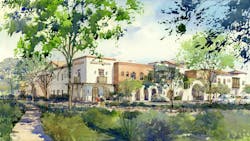Health + Wellness: Garden of Eden
The newest type of healthcare designation includes in-patient rehabilitation; and renovations and portions of new construction in the long-term care space are now being allocated to this new sub-set of patient designation. Hacienda at the River has embraced this model. It is the vision of award-winning senior-housing developer and operator David Freshwater and David Barnes of Tucson-based Watermark Retirement Communities.
After a transformative experience attempting to advocate for a loved one in a conventional healthcare setting, Freshwater envisioned a facility that would treat patients and their families in a holistic manner. “When my mom had back surgery and didn’t respond to pain medicine, we tried to introduce acupuncture.” But his attempts failed due to restrictions and a general lack of coordination.
Since then, Freshwater’s vision has been to implement “a center for excellence and innovation in senior living.” In collaboration with pioneers in holistic medicine at the nearby University of Arizona, the facility plans to establish alternative and holistic care for its residents and guests. UA’s Center for Integrative Medicine includes the Institute on Place and Well-Being, which includes the college of architecture, planning and the school of medicine. Founded by Dr. Esther Sternberg, author of Healing Spaces the Science of Spaces and Well-being, Sternberg’s cutting-edge research in the mind-body-place connection has been referenced by major organizations including the GSA. “Integrative therapies and pet therapies can physically affect the body,” says Sternberg.
A working horse farm and stables planned onsite at Hacienda on the River will foster the integrative care approach and provide residents and guests opportunities for equine therapy. Ohio State University did a study on the impact of horses and equine therapy for residents suffering from dementia, and they’re beginning to assess what’s actually happening from a neuroscience standpoint.
“It’s very creative how David is using this in elderly care to treat conditions that might appear in that environment,” comments Sternberg, who also points to successful integration of musical therapy, art therapy, meditation and canine therapy at the outpatient facility at Walter Reed hospital on the base in Bethesda, Md. “It’s changing the landscape of health and the landscape of design for green and sustainable buildings and the importance of the physical environment and the landscape environment for integrative medicine to foster those healthy activities,” says Sternberg.
The campus’ landscape is integral to the patient experience as well: Native and non-native trees and shrubs surround and connect the property’s courtyards, and the patios of the Hacienda Homes feature raised vegetable beds, potting tables and water-harvesting. Residents may raise flowers, vegetables and herbs, as well as harvest fruit from citrus trees; gardens and orchards will yield seasonal produce for the Hacienda, as part of nutrition-rich, anti-inflammatory diets.
A final innovative approach at Hacienda on the River is on the care-giver side, where there tends to be a lot of employee burnout and hence, turnover. In Hacienda’s setting, caregivers become companions. Called “Nayas,” Sanskrit for leader or guide, these universal caregivers will provide “expert support needed to optimize resident comfort and contentment,” says Freshwater. Nayas accompany their residents through daily routines, noting and observing recreation, diet, sleep habits, lucidity—even socializing. The system humanizes care-giver roles; and creates better health outcomes.
Hacienda at the River is expected to be complete in early summer 2016.
